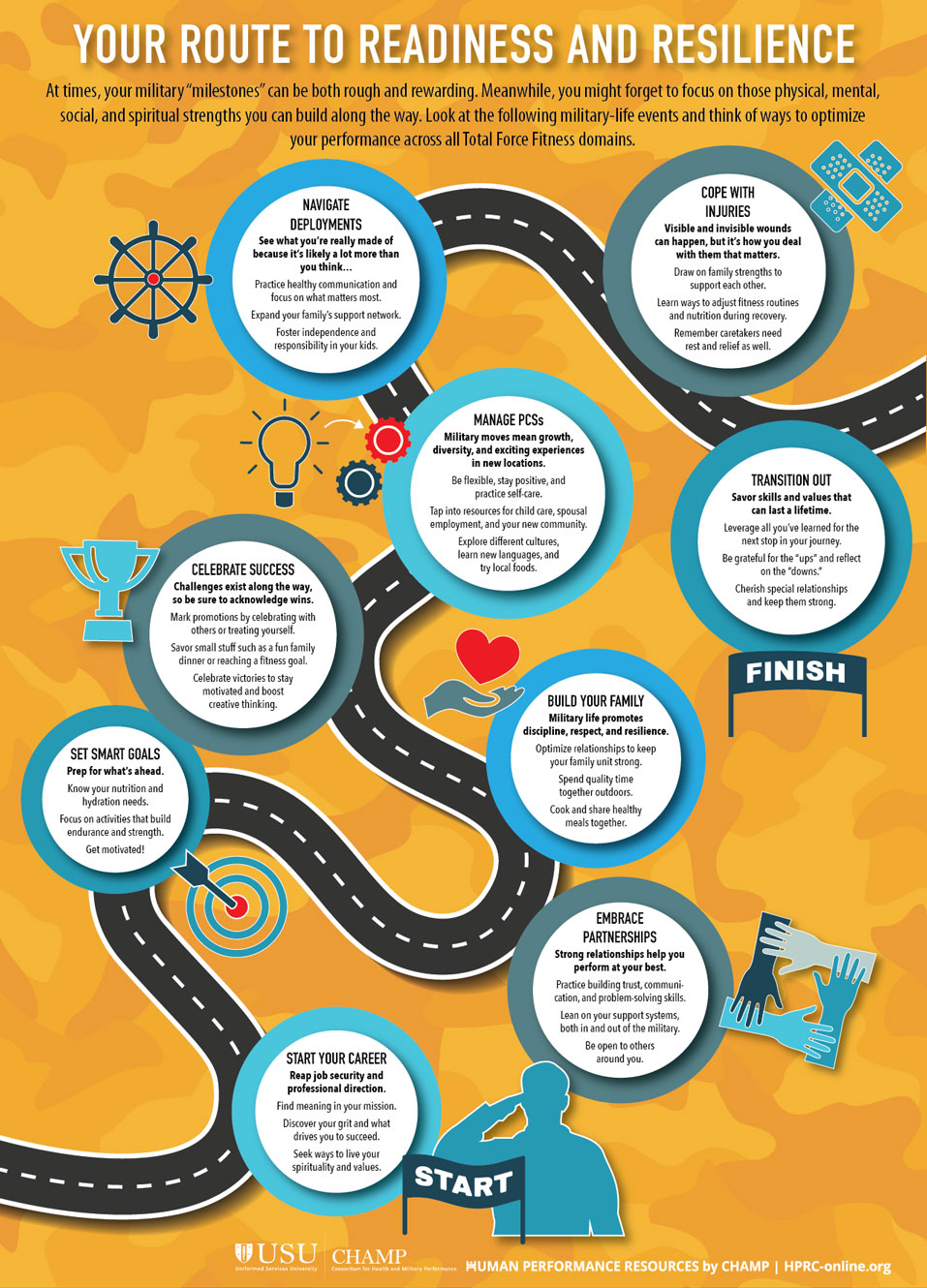Military life can be tough. But sometimes the most challenging moments of military life are also opportunities to build and showcase your strengths. With your family along for the ride, you all have a chance to grow together. Take a moment to think about where you are in your career and how you can optimize your readiness, resilience, and performance in the face of obstacles and transitions.

At times, your military “milestones” can be both rough and rewarding. Meanwhile, you might forget to focus on those physical, mental, social, and spiritual strengths you can build along the way. Look at the following military-life events and think of ways to optimize your performance across all Total Force Fitness domains.
Start.
Start your career. Reap job security and professional direction. Find meaning in your mission. Discover your grit and what drives you to succeed. Seek ways to live your spirituality and values.
Set smart goals.
Prep for what’s ahead. Know your nutrition and hydration needs. Focus on activities that build endurance and strength. Get motivated!
Embrace partnerships.
Strong relationships help you perform at your best. Practice building trust, communication, and problem-solving skills. Lean on your support systems, both in and out of the military. Be open to others around you.
Build your family.
Military life promotes discipline, respect, and resilience. Optimize relationships to keep your family unit strong. Spend quality time together outdoors. Cook and share healthy meals together.
Celebrate success.
Challenges exist along the way, so be sure to acknowledge wins. Mark promotions by celebrating with others or treating yourself. Savor small stuff such as a fun family dinner or reaching a fitness goal. Celebrate victories to stay motivated and boost creative thinking.
Manage PCSs.
Military moves mean growth, diversity, and exciting experiences in new locations. Be flexible, stay positive, and practice self-care. Tap into resources for child care, spousal employment, and your new community. Explore different cultures, learn new languages, and try local foods.
Navigate deployments.
See what you’re really made of because it’s likely a lot more than you think. Practice healthy communication and focus on what matters most. Expand your family’s support network. Foster independence and responsibility in your kids.
Cope with injuries.
Visible and invisible wounds can happen, but it’s how you deal with them that matters. Draw on family strengths to support each other. Learn ways to adjust fitness routines and nutrition during recovery. Remember caretakers need rest and relief as well.
Transition out.
Savor skills and values that can last a lifetime. Leverage all you’ve learned for the next stop in your journey. Be grateful for the “ups” and reflect on the “downs.” Cherish special relationships and keep them strong.
Finish.
Published on: April 10, 2019
References
Institute of Medicine. (2013). Military Families. In Returning home from Iraq and Afghanistan: Assessment of readjustment needs of veterans, service members, and their families. Washington, DC: National Academies Press.
Jex, S. M., Kain, J., & Park, Y. (2013). Situational factors and resilience: Facilitating adaptation to military stressors. In Building psychological resilience in military personnel: Theory and practice (pp. 67–84).
Kelly, D. R., Matthews, M. D., & Bartone, P. T. (2017). Grit and hardiness as predictors of performance among West Point Cadets. Military Psychology, 26(4), 327–342. doi:10.1037/mil0000050
Maddi, S. R., Matthews, M. D., Kelly, D. R., Villarreal, B., & White, M. (2012). The role of hardiness and grit in predicting performance and retention of USMA Cadets. Military Psychology, 24(1), 19–28. doi:10.1080/08995605.2012.639672
Meyers, L. L., Landes, S. J., & Thuras, P. (2014). Veterans' service utilization and associated costs following participation in dialectical behavior therapy: A preliminary investigation. Military Medicine, 179(11), 1368–1373. doi:10.7205/milmed-d-14-00248
Newby, J. H., McCarroll, J. E., Ursano, R. J., Fan, Z., Shigemura, J., & Tucker-Harris, Y. (2005). Positive and negative consequences of a military deployment. Military Medicine, 170(10), 815–819. doi:10.7205/milmed.170.10.815
Olson, D. H., & Olson, A. K. (1999). Preventive approaches in couples therapy. In R. Berger & M. T. Hannah (Eds.), PREPARE/ENRICH Program (2000 ed., pp. 196–216). Philadelphia, PA: Brunner/Mazel.
Park, N. (2011). Military children and families: Strengths and challenges during peace and war. American Psychologist, 66(1), 65–72. doi:10.1037/a0021249
Schok, M. L., Kleber, R. J., Elands, M., & Weerts, J. M. P. (2008). Meaning as a mission: A review of empirical studies on appraisals of war and peacekeeping experiences. Clinical Psychology Review, 28, 357–365. doi:10.1016/j.cpr.2007.04.005
Sripada, R. K., Bohnert, A. S. B., Teo, A. R., Levine, D. S., Pfeiffer, P. N., Bowersox, N. W., . . . Valenstein, M. (2015). Social networks, mental health problems, and mental health service utilization in OEF/OIF National Guard veterans. Social Psychiatry and Psychiatric Epidemiology, 50(9), 1367–1378. doi:10.1007/s00127-015-1078-2
Srivastava, S., McGonigal, K. M., Richards, J. M., Butler, E. A., & Gross, J. J. (2006). Optimism in close relationships: How seeing things in a positive light makes them so. Journal of Personality and Social Psychology, 91(1), 143–153. doi:10.1037/0022-3514.91.1.143
Weisenhorn, D. A., Frey, L. M., van de Venne, J., & Cerel, J. (2016). Suicide exposure and posttraumatic stress disorder: Is marriage a protective factor for veterans? Journal of Child and Family Studies, 26(1), 161-167. doi:10.1007/s10826-016-0538-y
Werber Castenada, L., Harrell, M. C., Varda, D. M., Curry Hall, K., Beckett, M. K., & Stern, S. (2008). Deployment experiences of Guard and Reserve families: Implications for support and retention. Santa Monica, CA: Retrieved from https://apps.dtic.mil/dtic/tr/fulltext/u2/a492576.pdf
